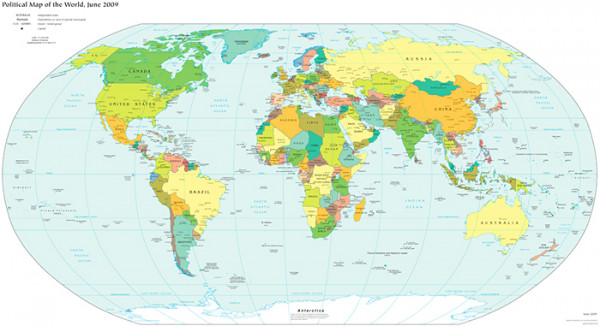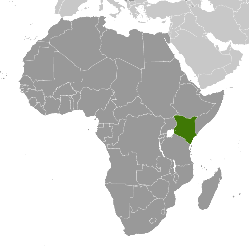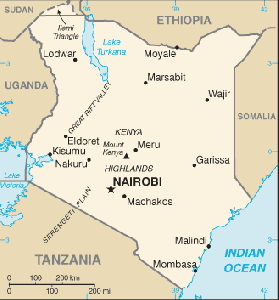Kenya: The place with ostriches
The country is named after Mount Kenya, a significant landmark and second among Africa's highest mountain peaks. "Kenya" means "place with ostriches" and is a reference to the black and white plumagefeathers covering a bird of male ostriches. When viewed from a distance, the snow-capped peak of the Kenya mountain is like the white feathers of a male ostrich.
Overview
| Flag |
|
| Anthem |
Ee Mungu Nguvu Yetu (O God of All Creation) |
| Capital |
Nairobi |
| Largest city |
Nairobi |
| Official language(s) |
Swahili / English |
Demonyma name for a resident of a locality, often the same as the name of the people's native language
|
Kenyan |
| Government |
Semi-presidential Republic |
| Area |
580,367 km2, 224,080 sq mi |
| Population |
~ 39 million |
| Currency |
Kenyan shilling (KES) |
| Internet TLD |
.ke |
Geography
The Republic of Kenya is a country in East Africa. It lies along the Indian Ocean to its southeast and at the equator. Kenya is bordered by Somalia to the northeast, Ethiopia to the north, Sudan to the northwest, Uganda to the west and Tanzania to the south. Lake Victoria is to the southwest and is shared between Kenya, Uganda and Tanzania.
Kenya comprises eight
provincesa territorial area within a country each headed by a Provincial
Commissioneran official in charge of a government department. The City of Nairobi enjoys the status of a full administrative province. At the same time, it is the capital of Kenya and its biggest city with a population of 2,940,911 people. Some other big cities are Mombasa, Nakuru and Kisumu.
Society and culture
Kenya is a very diverse country with many different ethnic groups. The Maasai culture is well known due to tourism, despite being a minor percentage of the Kenyan population. Kenya has an extensive music, television and theatre scene.
Population
Kenya has a population of nearly 39 million people which is very diverse: more than 40 different ethnic groups are present in the country. Kenya's population has
rapidlywith speed increased over the past several decades, and consequently it is relatively young. Some 73% of Kenyans are under 30. The largest ethnic groups are Kikuyu 22%, Luhya 14%, Luo 13%, Kalenjin 12%, Kamba 11%, Kisii 6% and Meru 6%. Only 1% of the population are non-African (Asian, European, and Arab).
Languages
Most Kenyans are bilingual in English and Swahili. A large percentage speak the mother tongue of their ethnic tribe. Swahili is a Bantu language with Arabic, Persian, and other Middle Eastern and South Asian loan words. It developed as a
lingua francaa common language used by people of diverse backgrounds to communicate with one another for trade between the different peoples.
Religion
The vast majority of Kenyans are Christian with 45% regarding themselves as Protestant and 33% as Roman Catholic.
Sizeableof considerable or relatively great size or extent minorities of other
faithsbelief and trust in someone or something do exist. There is a fairly large Hindu population (around 500,000), who have integrated well within the community and play a key role in Kenya's economy. 10% of the population are Muslim.
Government and politics
Kenya is a presidential representative democratic republic, whereby the President is both the head of state and head of government. The current president is Mwai Kibaki under the Party of National Unity.
Executivethe branch of government which is responsible for enforcing laws and judicial decisions, and for the day-to-day running of the state power is exercised by the government.
Legislativemaking, amending and repealing laws power is
vestedsettled, fixed or absolute, with no contingencies in both the government and the National Assembly. The
Judiciarythe branch of government which is responsible for maintaining the courts of law and for the administration of justice is independent of the executive and the legislature.
Economy
Kenya's economy is market-based, with a few state-owned infrastructure enterprises. The country is generally perceived as Eastern and Central Africa's
huba point where many routes meet and traffic is distributed for Financial, Communication and Transportation services. As at May 2010, economic
prospectsthe potential things that may come to pass are positive with 4-5% GDP growth expected, largely because of expansions in tourism, telecommunications, transport, construction and a recovery in agriculture. These improvements are supported by a large pool of English speaking professional workers. There is a high level of computer
literacythe understanding of something, especially among the youth.







